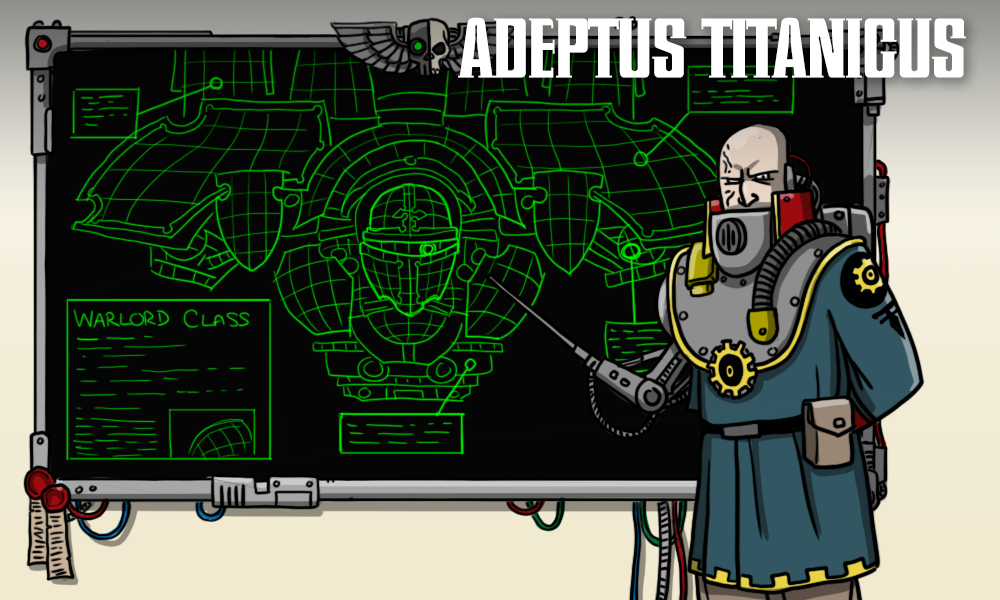A new Adeptus Titanicus release, in this economy? Today we’re reviewing the new Titanicus Campaign Compendium, a preview copy of which was kindly provided to us by Games Workshop.
It doesn’t feel like it, but Adeptus Titanicus came out five years ago! The initial release was followed up with a series of campaign books, containing lore, new maniples, rules for relevant legios and knight households, and new mechanics.
Collecting all of these supplements made onboarding new players difficult, which is why in 2021 the compiled Loyalist and Traitor books were released. These books collated all of the previously released content on how to field a force of a given allegiance in one handy place. This left all of the lore and other interesting content locked away in the older campaign books, which were now a harder purchase to justify.
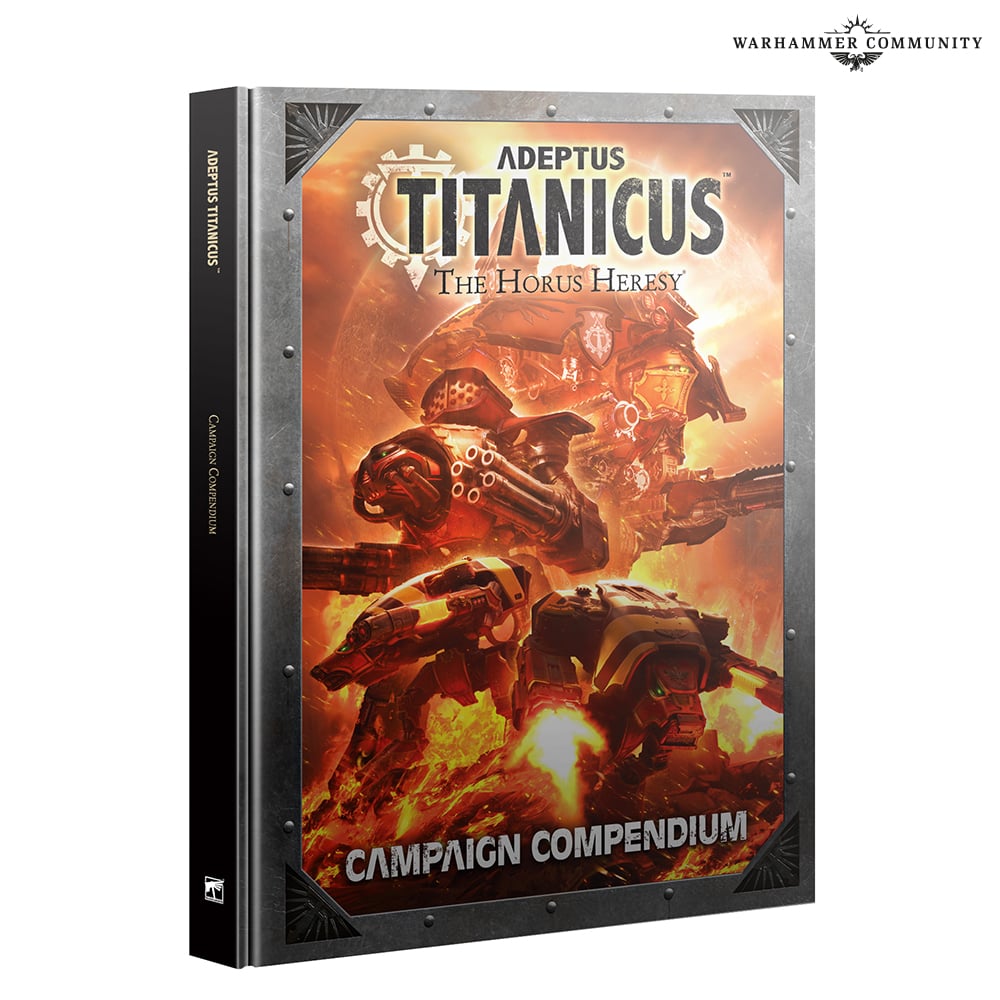
What if you wanted the content that was in the previous campaign books that was not included in the faction books? This is what the Campaign Compendium aims to solve.
So what’s in the book?
The Campaign Compendium is a hefty tome split into several sections:
- Lore and narrative missions
- Echoes of Glory
- Crusade Titan Legions
- Knight Household rules
- Campaign Rules
- Hostile Battlefields
Excluding the updated Crusade Titan Legions, all of this content is largely identical to its earlier printing spread across each campaign book. For the most part each of the categories caters to a different audience that may want to pick this up. Let’s look into these.
Crusade Legios

Let’s be real, this is likely what most people will pick this book up for. Crusade Legios enables you create your own custom Legio with a chosen mix of traits, upgrades, and stratagems.
This is the third iteration of these rules; each earlier iteration had something that was a tad broken. Third time lucky? This book takes it a step further and restricts some choices to stop certain combinations as well as introducing some new choices. This book specifically supercedes all previous publications of Crusade Legios, so if you plan to go to events you’ll need this book.
Creating a custom legio is fairly simple: pick 4 special rules amongst Traits, Wargear, and Stratagems. There’s some limitations here, though: you can only choose two from each category, and the traits are split into Majoris, of which you can only take one, and Minoris, of which you can take up to two. With the exception of the Majoris/Minoris distinction, this is basically how things have always worked, so if you’ve been playing a Crusade Legios list, chances are it’ll still work, and if it doesn’t you’ll only need to change one of your four choices.
Traits
Traits are divided between Majoris and Minoris traits – you are allowed up to two traits, only one of which may be a Majoris trait.
Bair: A big step in the right direction there, some traits are inherently more powerful than others so limiting some combinations is fantastic.
NotThatHenryC: Yes, but the traits that have become Majoris seems so arbitrary it almost looks random. There are Majoris traits that do trivial stuff for the command checks of nearby knights, while big hitters like Engines of War and Masters of Defence are rated Minor.
Maybe most importantly: you cannot use mutations for your titans at all unless you choose the Plaything of the Gods as one of your traits (which is a Trait Majoris). Given the amount of customisation and powerful combinations that mutations unlock, we’re glad to see this restriction to help curb some of the more finely tuned combos.
Of the Traits Majoris, Vanguard Fighters is here and unchanged, making your Warhounds and Dire Wolves better at hitting stuff when they’re out on their own. Duty and Honour also returns, and still allows Loyalist titans to use their Adaptive Tactics rule once each turn instead of once per game. Traits Minoris include common favourites like Engines of War, letting you swap titans within maniples for other chassis, and Masters of Defence, which lets friendly titans move at full speed in their rear arc, as well as react to charges by moving 3″ backwards and making an attack with one weapon, for the low cost of 1 pip of heat. The latter is an incredibly powerful ability against melee titans but even just being able to move full speed in reverse gives incredible flexibility and positioning, especially when you’ve got a nasty weapon equipped to fire back with.
Condit: While Masters of Defence is very good, it’s not going to protect you from a dedicated melee Legio like Vulpa or Laniaskara who tend to have enough tricks on the charge to score an engine kill without having to move to the combat phase. That said, against lists that are less all-in on melee, this can significantly blunt their damage output if they don’t roll incredibly hot on the charge. Additionally, you need to keep in mind that if the charging Titan still has voids up, dropping back 3″ is going to prevent you from firing into armor. Just keep that in mind before you decide to fall back outside of the charging Titan’s voids.
Wargear
As far as wargear upgrades go, Macro Charges sees a necessary nerf removing the +1S bonus that it previously granted; it still makes 3” templates into 5” templates and causes detonations from the weapon to hit at +2S. If you’re more of a melee-focused Legio, Armour Spikes gives you D6 smash attacks instead of D3, making Warhounds in Ferrox maniples significantly scarier on the charge. Tracking Gyroscopes is still an option, too, and still at 10 points; and unlike the generic version anyone can take these are available to Warmasters making their carapace gun much easier to fire.
Bair: Turning templates from 3” into 5” is Mordaxis’ upgrade, which also reduces the strength of that weapon by 1 as well. I’m glad to see the bonus strength removed but it’s still going to be a very popular choice making plasma blastguns hit targets more reliably on a larger blast.
Soggy: The strength of a Plasma Blastgun would be the first thing I would change about this game if I had the power, so I’m glad to see the bonus strength removed.

Stratagems
That leaves us with the Stratagem choices. These are just less often chosen, because you’re meant to lock in your stratagem choices as part of your Legio and then choose to take them or not in your games. The Matched Play guide does make this more flexible with your stratagem hand, but oftentimes there will be 2 traits and 2 pieces of wargear you want to take.
That said, there are some solid options here. One you may consider would be Blistering March, which allows Titans on Full Stride to fire 1 weapon for the cost of 1 pip of heat. Combine that with Vortex Payload Reavers with chainfists and you’ve go some potent melee threats moving across most of the table round 1 that still get let fly their terrifying vortex missiles.
Or you could look at Target Lock for when you absolutely need something dead right now. One of your Titans gives up its shooting to turn itself into a laser targeter, choosing an enemy titan within 12” and removing all penalties for your other titans to hit it, including from terrain or for making targeted attacks. This is a very solid choice for a legio with multiple Warhounds, as they can easily give up an activation to let the rest of their battlegroup take out a priority target.
Making it your own
The different options on offer allow you to create some truly flavourful combinations with their own different playstyles and narrative possibilities. And the changes to legio construction (and a handful of the options) help balance things out a bit more. It’s likely there are still some broken combinations in there, but that isn’t what you should be aiming to do.
Soggy: Don’t be that guy. Or do – we’re not your dad.
Knight Households
Instead of fielding an army based around one or more Maniples of Titans, you can instead field a Knight Household, based around Lances.
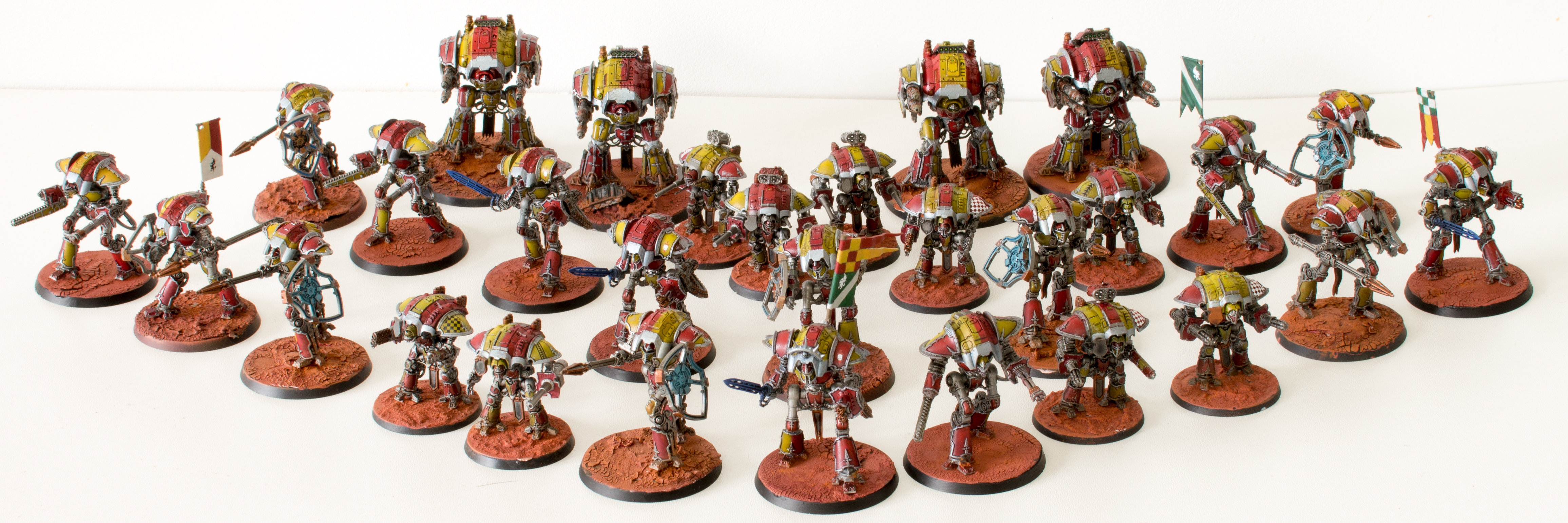
The Knight Household rules are virtually identical to those in Doom of Molech, plus the extra stuff in Defence of Ryza. It’s interesting to note that they haven’t copied in the errata that clarifies that knights have to move in a single straight line when charging. As such, not only does this book need an errata on release, but that errata was actually published several years ago.
This is a shame, because Doom of Molech is quite old and the game has moved on a bit since then. For example, there’s always been a bit of confusion over whether knights–who get their own list of stratagems here–can use stratagems that came out in later books. This was eventually answered by the Loyalist/Traitor compendiums, but this book uses the original wording preventing the use of any other stratagems.
This seems to leave us with multiple sets of rules for knight stratagems and it’s not clear which you can use. These rules say you can only have this very limited set. The Loyalist and Traitor books have their own much larger lists, but don’t include these ones. It’s not clear which set of rules should take precedence and neither seems right.
This is quite a big deal as–according to this book, anyway–commonly-used stratagems like Concealment Barrage and Vox Blackout cannot be used by Knight Households. Knight Households tend to get quite a lot of stratagem points because the leader of each Lance grants you more of them, so it’s nice to have stuff to actually spend them on. There’s also no reference to the new matched play book’s stratagem hand or how these rules would interact with it.

The Traitor and Loyalist Legio books include updated rules on assembling a Household Battlegroup and those are not here. So, as just one example, there’s no reference to Auxiliary banners or titans, or allegiance abilities. We assume this book isn’t intended to supersede those rules.
You get the matched play rules too, unchanged from the original. Households wouldn’t be able to do all the Titan missions, so they need their own set. This isn’t really needed if you have the matched play book – which you should get if you want to do matched play, but it does give you missions to play if you only have the core rulebook.
We then step into the additional Household rules published in Defence of Ryza. These let you use Battle Standards or the lesser Lance Standards, and also allow you promote your Seneschal to the High King if you want to give your opponent the satisfaction of killing him. It would have made sense to incorporate these into the Molech rules on assembling your Household, but they didn’t bother and pasted in the whole pages from Ryza at what feels like a slightly odd place.
Then we re-join Doom of Molech more or less where we left off, with the Molech Households. But House Devine is missing, presumably because (spoiler alert I guess) they made it into the Traitor Legios book. Here they actually have implemented the FAQ changes. They’re very minor things, mostly changing it so any Knightly Qualities from Doom of Molech that gave the Seneschal’s banner rerolls of 1 to hit in melee (which they already get due to being a High Scion’s banner) instead give their whole Lance rerolls of 1.
Many of these households got their own unique stratagems, which were only ever printed on the Knight Stratagems card set, not in Doom of Molech. They also aren’t printed here, but we gather the cards are getting a reprint if you want them. Some of them are actually quite good, so it’s worth getting hold of that deck if you want to play one of these Households.
Finally, earlier books have contained references to corrupted knights, so you might be wondering when we’d see those rules. Don’t worry, we are too; they aren’t contained here.
It was necessary to reprint the knight rules in this book. That gave the writers an opportunity to review how they worked, but instead they’ve really done the bare minimum by pasting in existing content. You’ll still need either the Loyalist or Traitor Legios book to play knights as mentioned above, which seems like a tremendous missed opportunity. If there’s a bright side to these Knight Household rules, it’s that there’s still room in the game for a dedicated Knight Households supplement. While they may not represent a huge proportion of the game’s players, we feel that Knight Households deserve the same attention that Crusade Legios–and the canon Legios, for that matter–have gotten over the lifespan of the game, and are hopeful that they’ll get it. Unfortunately, it’s just not here.
Lore and Narrative Missions
The campaign books focused on key battles throughout the Heresy where the God-Engines clashed. This is the meat of the Campaign Compendium – accounting for just over half of the book with the lore and narrative missions from the theaters below:
- The Titandeath of Beta Garmon, which saw the largest Engine War of the Heresy;
- The Doom of Molech;
- The Shadow and Iron Crusades of the five hundred worlds of Ultramar;
- The Defence of Ryza; and
- The Cataclysm of Iron, a conflict between the powerful Forge Worlds of the Segmenta Tempestus and Pacificus and hundreds of minor worlds.
The narrative missions let you retell some of the key Titanic engagements of the Heresy. Many of these missions are asymmetric and play with significantly more points than most people normally play, as well as on different board sizes to reflect the battle.
Some notable missions include:
- The Burning of Malhanr – this mission contains custom rules for how to run a Titan Duel, a minimalist format which supports games of under a thousand points without Maniples or Stratagems.
- Death of a God – a scenario which starts with an Imperator blowing up in the middle of the reeling Loyalist Deployment Zone
- Death of Salvation – in which Legio Crucius is caught in a pincer and has to put up a heroic last stand against waves of oncoming traitor forces
Campaign Rules
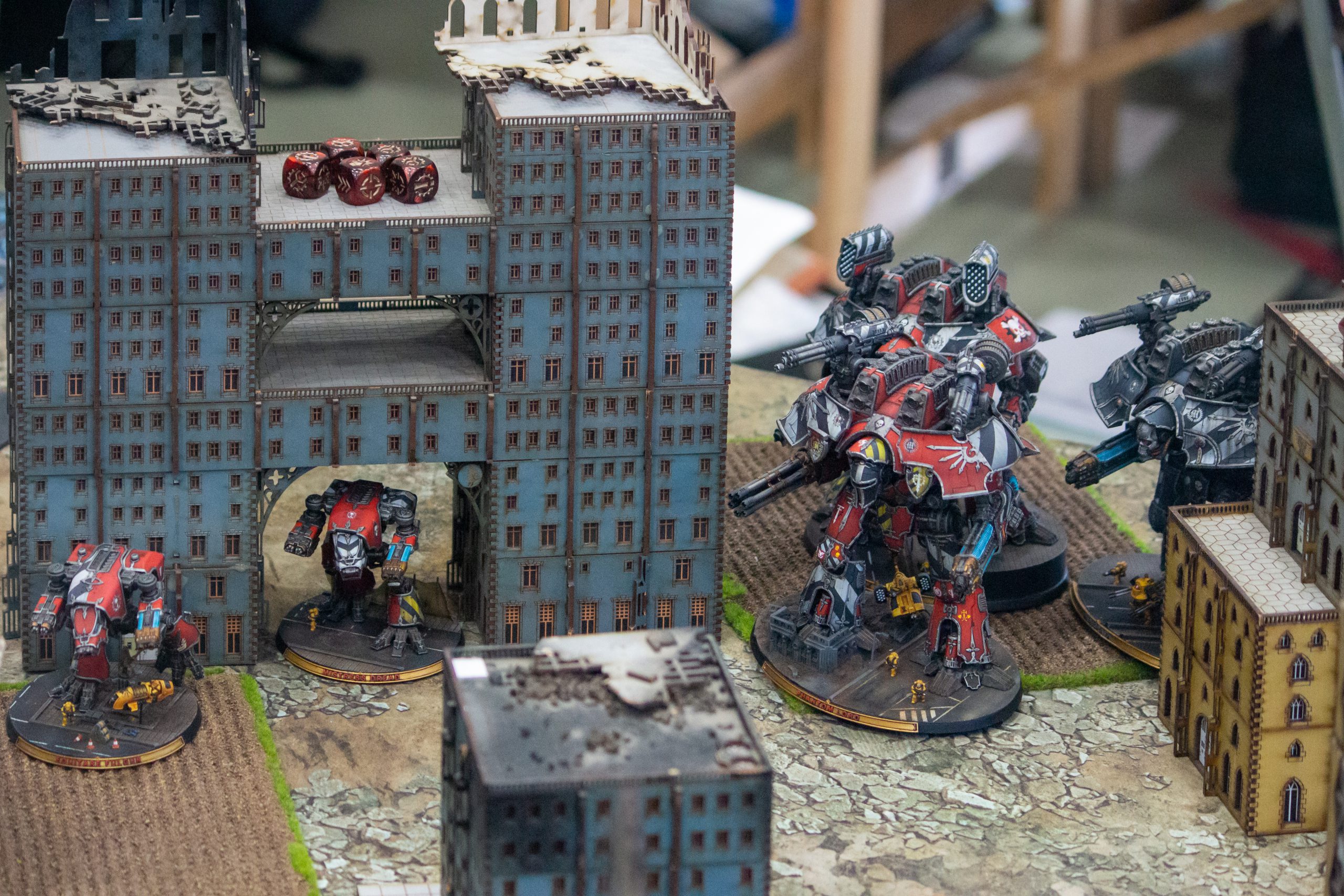
Adeptus Titanicus is a fantastic game for telling stories and memorable moments when a crazy chain reaction happened or a fluke shot silenced someone’s Warmaster titan. Campaign rules and frameworks were added to the game in the Doom of Molech and Shadow and Iron supplements, collated here now in the same place.
The campaign rules explore several ways of how to add additional depth to your games and how to string them together, spanning a subsector where you can vie for control of different worlds with their own inherent bonuses.
Rules are present on how to manage Legio and Knight Household Rosters, manage perpetual damage, crew skills and bespoke upgrades. If you have have a dedicated group and someone willing to run a campaign, then all the tools you need to get started are here. They can be a bit unwieldly at times, but not so much more so than 40k’s Crusade system that you’ll be put off if Titanicus is the game you really wanted to play.
Condit: For my money, the Shadow and Iron map campaign is the one to go with; the other options are good enough, but the map campaign rules are solid and benefit from having been included in one of the later campaign supplements. They take a lot of the ideas from previous books and expand on them in interesting ways.
Echoes of Glory & Hostile Battlefields
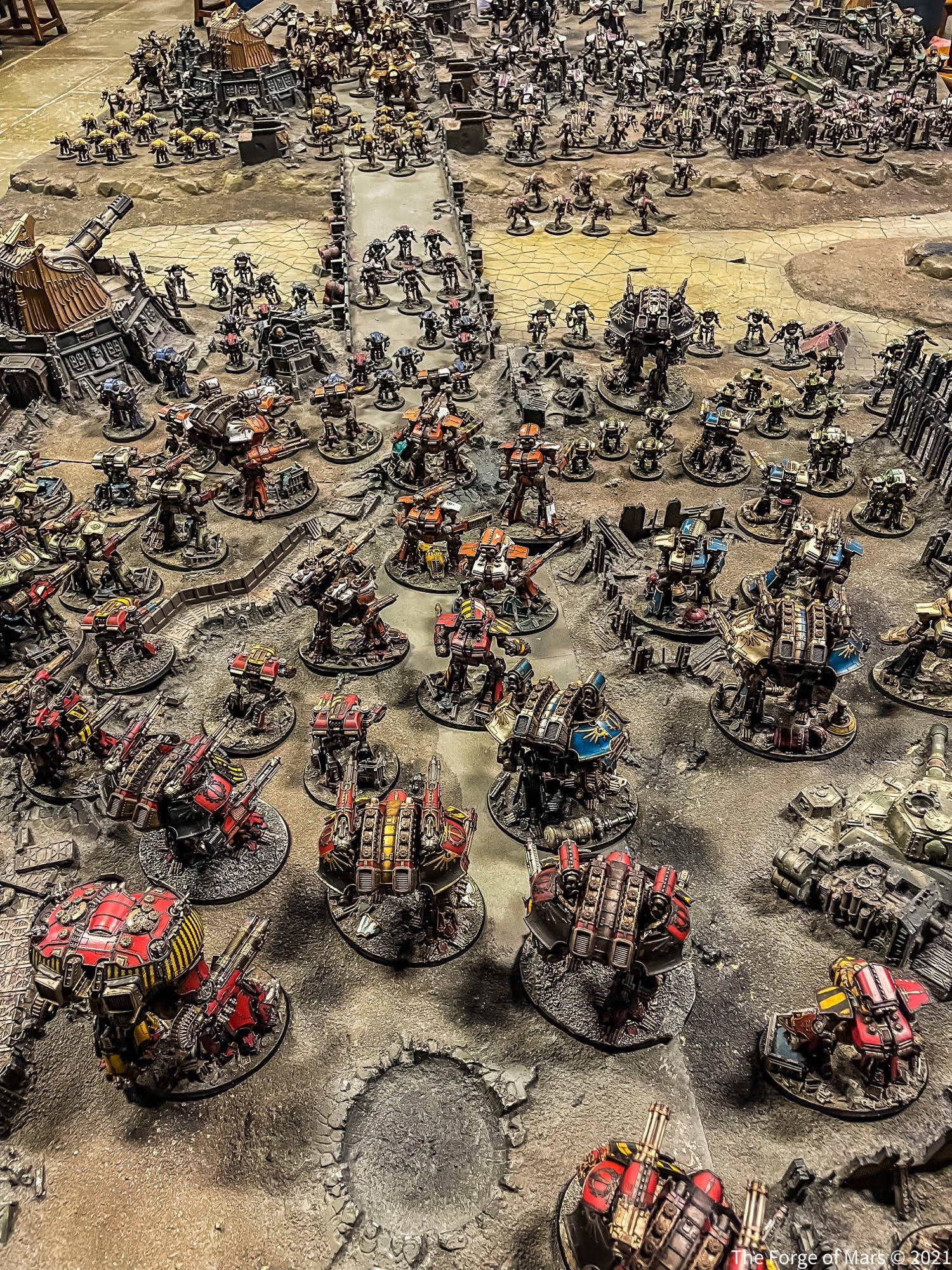
Echoes of Glory are a series of narrative missions from the Crucible of Iron supplement set in different environments: a Deathworld, Forgeworld or a Hive World. These are a series of “white label” scenarios that are perfect for pickup games or to use in your narrative campaigns
Soggy: I’d be lying if I didn’t take heavy inspiration from the Precipice scenario for one of the Goonhammer Open campaigns – which features strong winds blowing everyone into a bottomless chasm. It was the highlight of many people’s weekend!
Hostile Battlefields are a collection of special environmental rules to reflect different notable worlds which were included across several earlier supplements. Each world has a set of three different rules which make it quite distinct from another such as
- Ulixis, a world with massive underground caverns fought in pitch black, with chance of tunnel collapse and giant wyrms that may be attracted to the movement of your Titans walking.
- Ryza Secundus, a massive orbital plate upon which stray fire can cause hull breaches
- Beta-Garmon III, a world of foul weather whose caustic winds and lightning strikes will take their toll on your forces
These are an absolute goldmine as inspiration for creating your own missions or as something to add on top of a normal matched play game to fill in for the Open Engine War cards. That said, you’ll want to be careful with how many you use: the more effects you have in a game, the more likely you and your opponent are to just flat-out forget one.
All together now

Overall, it’s good to see the the content from the earlier campaign books collated in one place and seeing some changes in the right direction for Crusade Legions. The Knight Household section feels phoned in and a missed opportunity to tidy up some of their rules.
Should you pick this up? If you’ve got all of the previous campaign books, you can pretty comfortably take a pass on this. Unlike the Loyalist and Traitor books, there’s not really a lot to be gained here from compiling everything into a single tome, and unlike the Matched Play manual, there’s not really a lot of new ground being tread here.
If you’re missing at least a couple of those books, though, it’s still somewhat of a tough sell. If you want all the rules as published for Knight Households, they’re here, but you’re still going to have to refer to the FAQ and Errata documents to use them. And if you’re looking for some new ideas for a narrative event or a campaign with some friends, this book is chock full of stuff you can use.
The clearest case to be made for buying this book is if you’re one of those sickos who wants to run a Crusade Legio: the rules you’ll be using have changed, and this book has the most recent version of them, so if that’s your plan going forwards, you’ll need to pick this up.
Other than that, it’s really a question of how badly you’re looking for something new to shake up your games of Titanicus. If you’re desperate for new ideas for a mission and don’t have access to all of the previous releases for the game, this compendium is jam-packed with cool ideas that can either serve as full-on missions for you to play, or at least ideas that you can riff on to make new and interesting missions. But if you find yourself largely fine with the missions in the matched play book or the Open Engine War cards, you probably don’t need to buy this.
So what’s our verdict? It’s honestly hard to say, and depends on what you’re looking for right now. If something in the table of contents or in this review piqued your interest, go for it. Just don’t feel like this is mandatory purchase to play Titanicus. And that’s fine, given what this book is: it’s a compendium of optional campaign rules that not every table is going to need, or even want. But if they are something you want, this is the way to get them.
